No CrossRef data available.
Article contents
Optimal flight path planning for micro-UAV-based aerial imaging using the colony-based search algorithm
Published online by Cambridge University Press: 23 June 2025
Abstract
Micro-UAV systems used for metric purposes are highly capable of capturing relatively high-resolution, chromatically stable aerial images at low altitudes. In micro-UAV-based aerial imaging-based structure-from-motion (a-SfM) applications, the flight mission planning problem can be customised to achieve different objectives. The requirement for minimising the time spent in the air, which is crucial for energy conservation, can be achieved by designing the shortest possible flight path. Spatial resolution in the captured aerial images can be significantly preserved by maintaining the ground sampling distance (GSD) value within a 95 ${\rm{\% }}$ confidence interval throughout the flight path. Fuel efficiency can be improved by minimising the number of turning manoeuvers required to follow the flight path during the flying mission. In this paper, four distinct flight mission planning processes are delineated to enable the energy-efficient and effective implementation of aerial imaging missions, with their associated parameters optimised using the colony-based search algorithm (CSA). The obtained experimental results demonstrate that the proposed flight mission planning processes are highly successful in the energy-efficient and effective execution of aerial imaging missions.
${\rm{\% }}$ confidence interval throughout the flight path. Fuel efficiency can be improved by minimising the number of turning manoeuvers required to follow the flight path during the flying mission. In this paper, four distinct flight mission planning processes are delineated to enable the energy-efficient and effective implementation of aerial imaging missions, with their associated parameters optimised using the colony-based search algorithm (CSA). The obtained experimental results demonstrate that the proposed flight mission planning processes are highly successful in the energy-efficient and effective execution of aerial imaging missions.
Information
- Type
- Research Article
- Information
- Copyright
- © The Author(s), 2025. Published by Cambridge University Press on behalf of Royal Aeronautical Society


